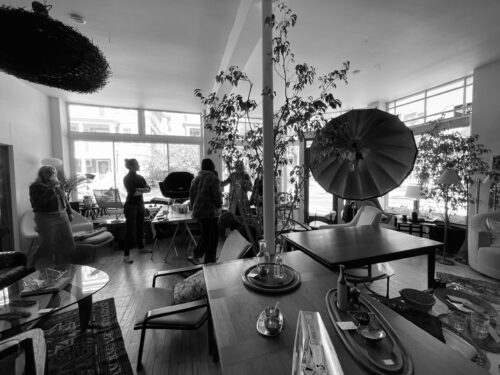Less than a ten minute walk from the quad was a photoshoot for the fall marketing campaign of Ouimillie (pronounced we-mill-ee). Ouimillie is a fully women-owned and operated interior design and fashion boutique based in Cambridge, and the boutique was started by Millicent Culter, pushing the focus of fashion towards curating small, local designers across the country. Upon entering the boutique, Millicent couldn’t be friendlier or more excited to discuss her passions—for fashion, for architecture and interior design, for inclusivity and representation in her boutique, and for her mission overall.
“The interior world informs the fashion world more than people think,” Millicent said. Her career as a curator of designers has led her to draw parallels across many different forms of media. She explained that both the fashion and the interior design world tend to have “the same fabrics, the same trends, and the same hardware”—in the end, they are fundamentally similar.
Millicent began her career in interior design, importing furniture from designers in France and Denmark to her small boutique. After deciding to add some clothing items to her shipments, she found that they sold much faster than her furniture, which gave way to a natural transition: her clothing pieces could be styled on the sales floor in a way that not only worked with the furniture, but complemented it. Expanding on her fashion business, she looked for designers closer to home.
“Post-COVID, the world has really started to gravitate towards the U.S., which is really exciting,” said Millicent. “For the first time in, I don’t know how long, we are considered the leaders of the fashion industry.” The models in the shoot wore belts from New York City, dresses from LA, and handbags from Boston.
The world of fashion cannot be run alone, and along with Millicent were many other players assisting in the shoot: models, hairdressers, makeup designers, and photographers.
Toan Trinh, a freelance photographer who specializes in fashion and used to work for the Boston Magazine, spoke with us at great length throughout the shoot. “I feel like you really need to be respectful of others’ work while creating your own,” he explained. In this photoshoot, Trinh aimed to capture what Millicent curated—not to overshadow it. “So many people get hung up on the setting or the models; they forget that the true story is about the clothes.”
This is an understandable issue, however, as it is difficult to pretend like this story isn’t all about the models. The group of four women gathered for this shoot were quite possibly some of the nicest and most welcoming people that one could meet, and each had their own unique perspectives on the world of fashion.
While talking with Millicent on her use of natural accessories and autumnal colors, the models completed their work. Bebe Wood (who you may recognize as Lake Meriwether on Love, Victor) was the youngest of the group; kind, bubly, and open to talk with us about her transition between modeling and acting. Samantha Guidry and Biz Morris, two other models on the scene, were busy changing between shoots, running back and forth between Millicent’s selection of fall themes. The final model on site was the incredible Pam Willis, who had the following the say about her role in the fashion industry:
“I’m a little older, and when I was growing up, I always thought you had to be stick-thin, twenty, not have breasts…and I have to say something that’s really inspiring in the fashion industry is that now we’re seeing people of every size, shape, age, and color.” Pam may call herself ‘a little older,’ but you’d never guess it; this also happens to be the proud owner of Pammy’s, and she insistently stressed her gratitude towards Millicent for curating such a space, not just for pretty girls wearing pretty clothes, but one where everyone can feel represented. “I’m just happy that my young girls—that are twelve and nine—are growing up in a much more inclusive world.”
This shoot was an incredible chance to catch a glimpse into the fashion industry at Ouimillie. What occurred was a well oiled machine—quick outfit changes, hair adjustments, cosmetic touch-ups, and pose flashes. However, the intimacy of this shoot challenged many expectations on the superficiality of the fashion industry: the models were constantly laughing, the photographer was forthcoming and vulnerable, the curator was passionately explaining her selections, and it was clear that there was nothing artificial about the friendships that emerged at the end of the event.
For these models, some of whom this was not their primary source of work, there must be something enchanting about being involved in the fashion industry: to have one’s finger on the pulse of current trends, to work with designers highlighting local industries, and to participate in the breaking of long-rooted stereotypes on the insincerity of the fashion industry. In contributing towards these endeavors, the women at this shoot were all doing something truly remarkable.
Daniel Ennis ’25 (djennis@college.harvard.edu) still doesn’t quite know how to dress.
Calvin Osborne ’25 (cosborne@college.harvard.edu) asks that you don’t listen to his fashion advice.

